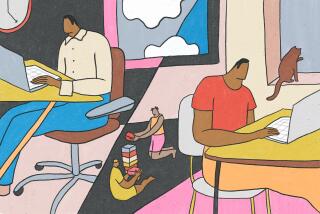Telecommuters cut the cord
- Share via
WASHINGTON -- — Frank Gruber’s workstation at AOL in Dulles, Va., could be in any cubicle farm from here to Bangalore -- pushpin board for reminders, computer on Formica desk, stifling fluorescent lighting. It’s so drab, there’s nothing more to say about it, which is why the odds of finding Gruber there are slim.
Instead, Gruber often works at the Tryst coffeehouse in the Adams Morgan neighborhood here, at Liberty Tavern in nearby suburban Clarendon, Va., at a Starbucks, in hotel lobbies, at the Library of Congress, on the Bolt Bus to New York or, as he did last week, beside the rooftop pool of the Hilton on D.C.’s Embassy Row. Gruber and Web entrepreneur Jen Consalvo turned up late one morning, opened their Mac laptops, connected to WiFi and began working. A few feet away, the pool’s water shimmered like hand-blown glass.
“I like the breeze,” Consalvo said, working all the while.
Gruber and Consalvo are digital nomads. They work -- clad in shorts, T-shirts and sandals -- wherever they find a wireless Web connection to reach their colleagues via instant messaging, Twitter, Facebook or e-mail and occasionally by voice on their iPhones or Skype. As digital nomads, experts say, they represent a natural evolution in telecommuting. The Internet lets millions of people work from home; now, with widespread WiFi, many have cut the wires and left home (or the dreary office) to work where they please -- especially around other people, even total strangers.
For nomads, the benefits are both primitive and practical.
Primitive: Tom Folkes, an artificial-intelligence programmer, worked last week at the Java Shack in Arlington County, Va., because he’s “an extrovert working on introvert tasks. If I’m working at home by myself, I am really hating life. I need people.” He has a coffee shop rotation. “I spread my business around,” he said.
Practical: Marilyn Moysey, an employee of Ezenia Inc. who sells virtual collaboration software, often works at a Panera Bread cafe near her home in Alexandria, Va., not at her office in the “boondocks.” Why? “Because there is no hope for the road system around here,” she said. Asked where her co-workers were, Moysey said, “I don’t know, because it doesn’t matter anymore.”
Nomad life is already evolving. Those who want co-workers gather in public places or at the homes of strangers. They work laptop-by-laptop, exchanging both business advice and idle chitchat with people who all work for different companies. The gatherings are called jellies, after a bowl of jelly beans the creators were eating when they came up with the name.
Although the number of digital nomads is intrinsically difficult to measure -- they are constantly in motion and difficult to pin down for polling -- evidence is mounting of a shift in where Americans work. Dell reports that its digital-nomad website is getting tens of thousands of hits a month. Panera logs 1.5 million WiFi sessions a month.
One of the inalienable rights of digital nomads is starting their workday well after many of their colleagues out at the cubicle farm have spent hours preparing for and getting to their workstations. Last week Gruber, a 31-year-old product strategist for AOL, edged into his workweek from home at 9:15 a.m., posting to his Twitter page, “It’s Monday, another busy week ahead!” Twenty-two minutes later, he posted a picture of his breakfast: two eggs, sunny side up. It wasn’t until about 11 that he arrived at the Hilton pool with Consalvo, his business partner.
Consalvo, 37, used to work for AOL -- during the stock option boom, she owned a boat she named Options -- but now she and Gruber are creating a Web start-up called Shiny Heart Ventures. By lunchtime they posted a picture of the pool to Flickr with the caption “Thank you, technology and other shiny objects that make working anywhere a breeze!”
Definition of shiny objects: their equipment. Combined, they travel with more than $10,000 in gear. They lug laptops, iPhones, back-up hard drives, power supplies and too many USB adapters to tally.
The attraction of working poolside is obvious, but why would an employer let workers pick venues that shout “leisure” rather than “productivity”? “It’s a win-win,” said Mary Barnes, Gruber’s boss at AOL, in an instant message chat. “Frank is happy doing what he loves, and from a business perspective, we gain valuable industry knowledge, contacts and insights.” She expects to see more nomads: “The younger workforce will demand it. That’s how they live.”
Carsten Sorensen, a London School of Economics professor who studies nomads, said people working outside an office often feel pressure to work harder to protect their freedom. This can make working as a nomad “both heaven and hell” and even lead to burnout, he said.
At Buzz Bakery in Alexandria, Va., last week, half a dozen people assembled for a jelly organized by Lacey Hopkins, a technical writer. “Extroverted people like me get their energy from other people,” she said.
Slightly more formal co-working centers have opened nationwide, including Affinity Lab in office space above the Diner in Adams Morgan. Ads posted at the Tryst coffeehouse offer space to the nomad who doesn’t want a formal office but still wants a community of people to swap ideas with -- and a fax machine. Members pay $235 a month to work in a communal room -- no desk included -- or $575 for a desk. Users include designers, software start-up entrepreneurs, nonprofit group staffers and an importer of Chilean wine.
Gruber and Consalvo intend to remain “location independent” throughout their work lives. “In real estate, the emphasis is always put on ‘location, location, location!’ and thanks to ever-evolving technology, we can now be productive from almost any location,” they say on their website. “And while we understand that there is no place like home, we like to think we have many homes -- the primary one being the World Wide Web.”






